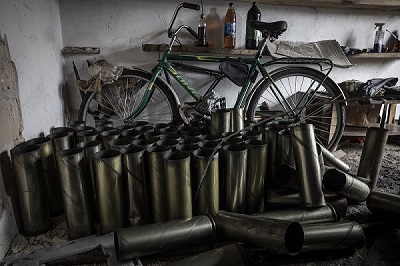
Used 105mm shell casings are stacked in a civilian garage on the outskirts of Chasiv Yar in the Donetsk region of Ukraine on April 21, 2023.
12:21 JST, May 19, 2023
When Ukrainian President Volodymyr Zelensky made a whirlwind tour of Western capitals this week, the billions of dollars in new military support was a sign that European governments were finally digging deep to provide sustained backing for a protracted war.
Zelensky had made clear ahead of his visits to Berlin, Paris and London that Ukraine’s much anticipated counteroffensive could not begin until more weapons and ammunition had been secured.
But while British deliveries of long-range missiles known as Storm Shadows could significantly enhance Ukraine’s offensive capabilities, much of the weaponry pledged by European leaders this week is unlikely to reach the battlefield until well after the start of the counteroffensive, military experts say, and Europe’s ability to sustain such support into the future remains unclear.
Western governments, in particular European ones, have failed to act fast enough to turn around their industrial policy to meet Ukraine’s growing needs for artillery ammunition, armored vehicles and other weaponry, military experts said. Kyiv’s existing stores of Russian-made equipment are becoming depleted, as are the West’s own stockpiles, raising the risk of shortages in supplies for Ukraine by the end of the year, which will hamper Ukraine’s ability to launch any further offensives, these experts said.
“The penny has dropped that this might go on longer and that you have to invest in your industry if we are going to make this sustainable,” said Jack Watling, senior research fellow for Land Warfare at the Royal United Services Institute, a British think tank. “The fact of the matter is that this was obvious in April last year, but people sat on their hands.”
Explosions rocked Kyiv early Thursday, as Russia continued a wave of strikes on the Ukrainian capital. An air raid alert remained in place, and residents were urged to stay in shelters. Debris from missiles fell on the city, but no casualties were reported.
Ukraine’s air force said it destroyed 29 of 30 missiles and four drones during the overnight strikes, which city officials in Kyiv said was the ninth air attack on the capital this month. At the Pentagon, spokeswoman Sabrina Singh says that the air-defense Patriot system damaged in Ukraine in a recent Russia attack has been fixed and is operational.
There is a growing realization in Western capitals that the piecemeal assistance to Ukraine so far may not be sufficient to allow Kyiv to make more than localized breakthroughs along the 900-mile front line where Russia has spent months fortifying its positions.
“History suggests even the stupid are capable of learning and one of the things we should be very conscious of is that Russia knows this offensive is coming,” said Gen. Richard Barrons, former commander of the British Army’s Joint Forces Command.
The flurry of new weapons agreements has not “changed the brutal dynamic of this, which is that the Ukrainian force that is able to execute this offensive . . . is as big as it’s going to be. It’s got what it’s got,” Barrons continued. “The offensive should have some effect, but it won’t throw every Russian out of Ukraine. In other words, this cannot be the last act in the war, if you are going to keep it going.”
And some in Moscow echo that assessment and appear confident that Russia’s military can largely hold its positions, though nervousness is growing over long-range missile supplies and whether Kyiv can break through the land bridge that Russia has carved to the Crimean Peninsula, which would be seen a significant blow.
“Over the last few months, a lot has been done to strengthen the defense lines,” said a longtime member of Russian diplomatic circles who remains in touch with colleagues in the government and spoke on the condition of anonymity to discuss sensitive matters. “This doesn’t mean that the Ukrainian counteroffensive can’t achieve any aims. But it means that any attack will be accompanied by significant losses.”
Russia’s full-scale invasion in February 2022 shocked a continent that had for decades funneled its “peace dividend” into economic growth and social spending, while shrinking its armies and hollowing-out arsenals.
“European militaries over the years had not focused on major war in Europe,” said Camille Grand, who was until last year NATO’s assistant secretary general for defense investment and is now a distinguished policy fellow with the European Council on Foreign Relations. “That was not core to the planning, and they were not stockpiling ammunition in sufficient numbers for that type of contingency.”
NATO spokesperson Oana Lungescu said the alliance was “continuing to work to rapidly address shortfalls in ammunition stockpiles, enhance interoperability and interchangeability and strengthen the transatlantic industrial base.”
“Several allies, including the United States, the United Kingdom, Norway and France, have already signed large new contracts with the defense industry, enabling them to invest in increased production capacity,” Lungescu said. NATO declined to provide additional details on the contracts.
Much of the announced military aid to Ukraine from Western governments has been sourced from equipment that would have gone out of service anyway, Watling said. “Most of what we have given is stuff we have already paid for a long time ago, and we would have had to pay to decommission it. . . . We are now talking about a situation where we have to put money on the table because we have to invest in industrial capacity.”
The stakes are rising as Russia seeks to paint its war in Ukraine as a battle against the liberal democracies of what it calls the “collective West.”
“If we do not stop this threat in Ukraine, it is a threat that we will have to deal with in our own countries, and that is a much more expensive process than doing this. The opportunity here is that we rejuvenate our manufacturing and defeat our main security threat without having any of our own infrastructure targeted or our personnel killed,” Watling added.
In the immediate aftermath of the invasion, allies moved quickly to sanction the Kremlin and to rally support to the Ukrainian cause, but adopted a bit-by-bit approach on lethal aid, pushing back on Ukrainian requests for certain weapons, before eventually relenting and sending them – then repeating the pattern again.
NATO Secretary General Jens Stoltenberg helped put the focus on ammunition at a meeting of NATO defense ministers in February, warning that Ukraine was chewing through ammunition much more quickly than it could be produced. Wait times for new large-caliber ammunition had grown from 12 to 28 months, he said.
“Just as important as supporting a successful offensive is an industrial policy to match the scale of the war and we don’t have that yet,” Barrons said. “The most galling thing is that we have lost 13 months of war before we have begun to ramp up industry. We have not seen the sort of industrial activity to give Ukraine the stuff it needs to fight at scale.”
The European Commission this month announced a 500 million-euro plan to boost production in Europe of the artillery shells Ukraine needs. Military experts say that although the initiative marks a significant shift, it has been too slow to act. The E.U. is yet to issue any new contracts, Watling and Barrons said, and there has been protracted wrangling over how a separate 1 billion-euro program would be spent to purchase further artillery shells and missiles.
Last year, the Ukrainian army was blasting through 180,000 artillery shell rounds per month. Before the war, U.S. production stood at 14,500 shells per month, and E.U. production was around the same. The United States has been faster to respond to depleting stockpiles, boosting domestic production to 20,000 rounds a month and investing in new capacity to eventually increase that to 90,000 rounds per month.
But Ukraine is still expending 90,000 to 140,000 rounds a month, according to Watling, while the newly announced E.U. investments in production could take one to two years to come online, despite a call by Thierry Breton, the European commissioner for the internal market, to move into “war economy mode.”
“You don’t have to be a great military analyst to realize that European countries making major investments into artillery production 13 months into the war are a little bit late,” said Michael Kofman, director of the Russia studies program at the Center for Naval Analyses. “What’s important is the U.S. has already significantly increased its artillery production. But there’s greater capacity in Europe. It is incumbent upon them to leverage their defense industries and to spend the money.”
Others argue that the recent E.U. announcements are still an important message to Russia. “Russia is betting on the fact it can wait out Western resolve. A months-long time frame sends the signal that solidarity holds and support will continue,” said a senior E.U. diplomat who spoke on the condition of anonymity to brief the press. “The numbers [of shells] don’t have practical meaning. It’s that it is sustained.
“It sends the message to the Kremlin that, ‘No matter what you think, our policy is set for longer,'” the diplomat continued.
Signs are emerging of a parallel effort in Russia to increase production, despite Western sanctions. Data recently published on Russia’s federal treasury website showed Moscow spent 2 trillion rubles ($26 billion) on defense in January and February alone, a 282 percent increase over the same period in 2021, Reuters reported on Monday. Russia is on course to produce 2.5 million artillery shell rounds this year, up from 1.7 million before the war, Watling said.
In response to an E.U. pledge to supply Ukraine with 1 million artillery shells over the next 12 months, Russian President Vladimir Putin retorted in March that Moscow would produce three times as many shells over the same period.
“Russia has the capacity to mobilize its own economy in support of the armed forces and control its own destiny in a way that Ukraine can’t,” said Barrons. “The critical weakness” for Ukraine “is its reliance on Western inventory and industry.”
"News Services" POPULAR ARTICLE
-

American Playwright Jeremy O. Harris Arrested in Japan on Alleged Drug Smuggling
-

Japan’s Nikkei Stock Average as JGB Yields, Yen Rise on Rate-Hike Bets
-

Japan’s Nikkei Stock Average Licks Wounds after Selloff Sparked by BOJ Hike Bets (UPDATE 1)
-

Japanese Bond Yields Zoom, Stocks Slide as Rate Hike Looms
-

Japan’s Nikkei Stock Average Buoyed by Stable Yen; SoftBank’s Slide Caps Gains (UPDATE 1)
JN ACCESS RANKING
-

Keidanren Chairman Yoshinobu Tsutsui Visits Kashiwazaki-Kariwa Nuclear Power Plant; Inspects New Emergency Safety System
-

Imports of Rare Earths from China Facing Delays, May Be Caused by Deterioration of Japan-China Relations
-

University of Tokyo Professor Discusses Japanese Economic Security in Interview Ahead of Forum
-

Japan Pulls out of Vietnam Nuclear Project, Complicating Hanoi’s Power Plans
-

Govt Aims to Expand NISA Program Lineup, Abolish Age Restriction





















